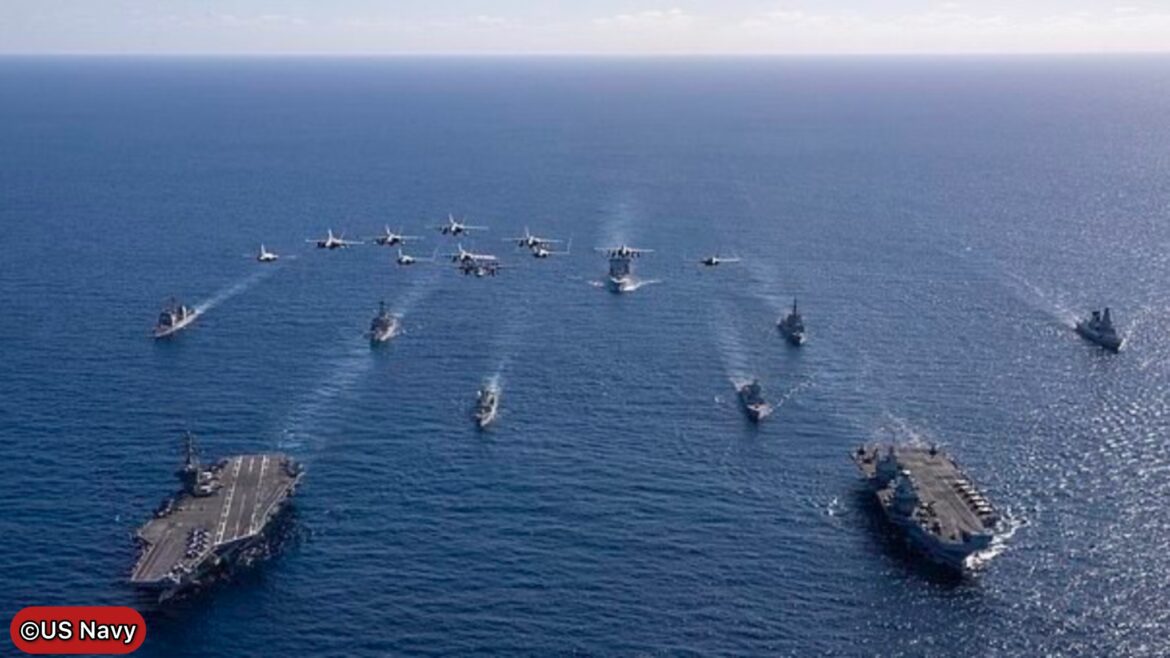HMS Prince of Wales and USS George Washington sailed together in the Timor Sea on Friday in an unprecedented display of allied naval power, as Western nations reaffirm their commitment to Indo-Pacific security amid growing concerns over Chinese military expansion. The joint operation, part of the massive Talisman Sabre 2025 exercise, marks the first time British and American aircraft carriers have operated together in the multinational drill since it began in 2005.
The 65,000-tonne HMS Prince of Wales, Britain’s largest ever warship, joined the nuclear-powered USS George Washington in coordinated manoeuvres involving 35,000 personnel from 19 nations. The exercise comes as defence officials warn of increasing Chinese preparations for potential military action against Taiwan.
This powerful demonstration of naval power brings together advanced capabilities and carrier aviation, including HMS Prince of Wales‘ air group of F-35B Lightning jets,” the Royal Navy stated in an official release on Friday.
Historic Naval Cooperation
The dual carrier operations represent a significant escalation in Western military cooperation in the region. HMS Prince of Wales carries two dozen F-35B fighter jets from 809 Naval Air Squadron and 617 Squadron, whilst USS George Washington operates with Carrier Air Wing 5, including advanced F-35C stealth jets.
Commodore James Blackmore, Commander of the UK Carrier Strike Group, described Friday’s exercise as a “real demonstration of the UK and our partners’ warfighting capabilities.” The operation involved complex coordination between multiple allied vessels and aircraft across vast stretches of ocean.
The British carrier was accompanied by destroyer HMS Dauntless and tanker RFA Tidespring, alongside allied vessels including HMAS Sydney from Australia, HNoMS Roald Amundsen from Norway, and HMCS Ville de Quebec from Canada. The American strike group included cruiser USS Robert Smalls and destroyer USS Shoup.
Growing China Concerns
The timing of the exercise is particularly significant as tensions mount over Taiwan. US Secretary of Defence Pete Hegseth warned at the recent Shangri-La Dialogue security conference that a Chinese military attack against Taiwan “could be imminent,” adding that “the threat China poses is real.
Taiwan has dramatically increased its own defence preparations, conducting unprecedented “whole of society” drills this week. The exercises, which lasted 10 days and involved 22,000 reservists, simulated responses to potential Chinese invasion scenarios.
We are learning from the situation in Ukraine in recent years and realistically thinking about what Taiwan might face in real combat,” a senior Taiwanese defence official told Reuters, speaking on condition of anonymity.
China has rapidly expanded its military capabilities, with Naval News reporting in January the construction of new amphibious barges at Guangzhou Shipyard that could facilitate invasion operations. Military analysts note Beijing has been building the equivalent of the entire Royal Navy in just four years.
Strategic Implications
Defence Secretary John Healey emphasised Britain’s unwavering commitment to the region. “We will continue to work alongside our closest allies to maintain the security and stability that underpins global prosperity,” he said.
The deployment, codenamed Operation Highmast, represents the second time this century a Royal Navy carrier strike group has operated in the Indo-Pacific. The eight-month mission will see the task force conduct exercises across the Mediterranean, Middle East, and western Pacific.
Military experts view the 2027 timeframe as particularly critical, with US Indo-Pacific Commander Admiral Samuel Paparo warning that China’s drills around Taiwan are “not just exercises – they are rehearsals.” CIA Director William Burns has previously stated that Chinese President Xi Jinping has instructed his military to be capable of seizing Taiwan by force by 2027.
Russian Naval Activity
The Pacific deployment comes as Royal Navy vessels remain heavily engaged monitoring Russian naval movements closer to home. During the first week of July alone, British warships and helicopters shadowed five Russian vessels in UK waters.
HMS Iron Duke, HMS Tyne, and Wildcat helicopters from 815 Naval Air Squadron conducted three separate operations in the North Sea and English Channel between 1 and 8 July. The operations tracked two Steregushchiy-class corvettes, a tanker, bulk carrier, and a Smolnyy-class training ship.
Russian warships are increasingly sailing through the English Channel, and every time they do, a Royal Navy vessel will be keeping an eye on them,” stated Luke Pollard, Minister for the Armed Forces.
Remembering Pope Francis
HMS Prince of Wales flew its ensign at half-mast during the deployment as a mark of respect for Pope Francis, who died on 21 April at age 88. A Royal Navy spokesman confirmed the gesture honoured the late pontiff, whose death prompted nations worldwide to lower flags in tribute.
The carrier had departed Portsmouth on 22 April, just one day after the Pope’s passing, with crowds cheering and waving flags as the warship left harbour. President Donald Trump ordered all US federal and state flags to fly at half-staff until the day of interment.
Future Operations
Military analysts suggest the current exercise demonstrates enhanced Western resolve in the face of authoritarian expansion. The UK has not confirmed whether HMS Prince of Wales will transit the contentious Taiwan Strait during its deployment, a move that would represent a significant escalation in Western pushback against Chinese territorial claims.
The 2021 deployment of HMS Queen Elizabeth avoided the strait, leading to criticism from some MPs that Britain was seeking to appease Beijing. Any decision to transit the waterway would send a strong signal about British commitment to freedom of navigation.
As Talisman Sabre continues until 27 July, the combined carrier operations underscore what defence officials describe as a new era of military cooperation designed to deter aggression and maintain stability in one of the world’s most strategically vital regions.
Follow for more updates on Britannia Daily



